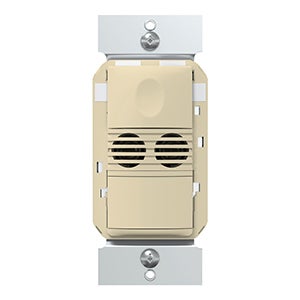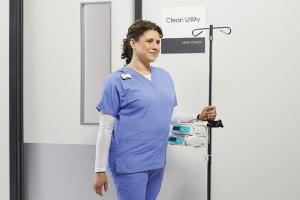Lighting manufacturers offer advanced solutions

Image courtesy of Cooper Lighting Solutions
Lighting equipment and controls have reached a new level of connectivity for hospitals and other health care facilities, with innovations such as wireless controls, patient-centric aesthetics and operability, and more precise management of light intensity and color attracting attention.
Lighting for specific areas, such as imaging spaces, pharmacies and parking structures, has also been tweaked by lighting manufacturers. Additionally, fixtures for ligature resistance and disinfection continue to be introduced.
Amid all these advances, hospitals still pose challenges to manufacturers. Spatial constraints, especially in older hospitals, are one. Ceilings often have obstructions such as HVAC and sprinkler systems that hinder the installation of luminaires, according to Patricia Rizzo, health care segment manager at BalancedCare by Axis Lighting, Montreal. “Smaller, modular lighting forms that allow for flexibility of placement while providing optimal light distribution are important.”
Smaller, off-campus health care facilities present their own sets of challenges. Because these facilities have limited budgets, simple stand-alone controls from a single manufacturer are ideal, particularly with multilocation operations that operate not just within a state but nationally, according to David Buerer, director of product management, Leviton, Melville, N.Y.
While some needs — sealed housings, antimicrobial finishes and multifunctionality — remain the same, these smaller facilities often require smaller luminaires. “To address this need, Kenall offers luminaires as small as 1-by-1-foot as well as a variety of shapes, including slots and 24-inch round luminaires,” says Bill Blackley, senior director of marketing at Kenall Manufacturing, Kenosha, Wis.
Making connections
As lighting control technology becomes more digitally connected, health care facilities are moving away from standard wired controls to wireless offerings that help them improve the environment.
The Internet of Things (IoT) is a big part of this trend. Smart devices and motion sensors in lighting equipment make it possible to improve the tracking of patient activities throughout their stay, which can lead to faster recovery. It also provides easy in-room control.
While demand for wireless lighting controls is growing, wired lighting control solutions are still more prominent in hospitals, says Martin Mercier, senior marketing manager at Cooper Lighting Solutions, Peachtree City, Ga. “However, wired lighting controls are evolving into more advanced solutions. For example, in patient rooms, digital app-based solutions are replacing relay room controller solutions and are used in conjunction with pillow-speaker controls.”
Digital lighting control solutions make it easy to reprogram lighting scenes for over-the-bed lighting and to create additional zones in a patient’s room, such as over the TV monitor, Mercier adds. “Setting up and reprogramming default light levels and controlling lighting colors from warm to cool is easier, too. Now that LED products — including variations of white, primary and secondary colors — have become more cost-effective and lighting controls are easier to use, the number of tunable white projects is increasing.”
Improving energy efficiency is a major benefit of new lighting control systems. “Energy savings strategies, such as occupancy sensing, daylight harvesting and scheduled lighting setback, drive at least 30-50% of energy savings on top of any transitions to energy-efficient LED lighting,” says Steve Roe, vice president of controls solutions at Acuity Brands, Atlanta.
Fixtures with embedded controls are another trend. “Embedded luminaires are manufactured, tested and shipped with the control already present in the luminaire,” Roe says. “Embedded controls offer benefits, such as simplified space design, low installation cost and easy energy code compliance.”
Another trend sees hospitals striving to mimic hospitality environments and their architectural designs, according to Ethan Garrett, product and marketing manager for Alkco at Signify, Bridgewater, N.J. “The right LED and connected lighting can help with this, creating a similar sense of comfort for patients during their stay. At the same time, it can enable facilities managers to achieve up to 75% in energy savings.”
From a controls perspective, simple is best, manufacturers say. Intuitive controls that do not require staff training, are located at point-of-use and do not fail are essential. Lastly, lighting equipment that is easy to install, provides room-side access and quick disconnects for easy maintenance is the best solution.
Another trend sees hospitals installing more patient-centric lighting, not just for aesthetics and controllability but to provide infection control and to promote a natural circadian rhythm, says Blackley. “Kenall has invested in tunable white and BIOS SkyBlue lighting technologies because they positively impact sleep cycles and the health of patients.”
Tim Stevens, director of product management at Certolux, a Leviton lighting company based in Toronto, sees hospitals installing more continuous disinfection lighting systems that use less power than previous systems. “Leviton’s WavePort technology provides disinfection without sacrificing visible light quality.”
Recent introductions
Acuity Brands recently launched the nLight (rSI) wireless system input device for patient room pillow switches. A single contact from a pillow switch can be used to turn fixtures on or off, and to raise or lower light levels. With multiple inputs and programming options, the nLight rSI works with single- and double-pole pillow switches and provides multifunction control with wireless switches in the room.
“The rSI features universal inputs, customization, local or systemwide inputs, LED status indicators, BACnet and the ability to select a wireless frequency to avoid interference with other active systems,” Roe says.
Signify recently reintroduced the Alkco brand as its primary health care luminaire portfolio — refreshing it with new technologies. For example, the Alkco EvoSeal luminaire, which delivers visually comfortable illumination, now comes standard with AccuRender technology for high color rendering and consistency without sacrificing efficacy or visual comfort. It’s also available in tunable white and with BioUp technology, which helps support the biological benefits of natural daylight indoors.
“With available sensors, EvoSeal makes it easy to unlock the potential of the IoT and gain value beyond illumination,” Garrett says. “Compatible with Signify’s Interact connected lighting system, it can monitor and collect a wide range of data, from energy consumption to space utilization, and also integrates with building management systems.”
Signify also has updated its Ledalite Nature Connect natural lighting system. Built on biophilic design principles, it simulates a 24-hour daylight cycle, supporting building occupants’ natural circadian rhythms and creating healthy, inspiring environments, Garrett says. “We’ve simplified its user interface and enhanced its controllability, making it easier for patients and staff to select the right natural lighting scene for their activity or need.”
Leviton recently introduced Intellect wireless integrated sensors and fixture controllers for Intellect-enabled fixtures. The controllers install directly into luminaires to support networking in Leviton’s GreenMAX DRC wireless system for fixture control as part of a wireless lighting control system, according to Buerer.
“The controllers future-proof spaces and add flexibility to easily modify and reprogram lighting controls to meet the changing needs of spaces,” Buerer says. “The plug-and-play wireless mesh system enables multizone occupancy and vacancy sensing, daylight harvesting, partial-on/off and manual control. Virtually any fixture can be Intellect-enabled to achieve an integrated in-fixture wireless control solution.”
As a stand-alone solution, Leviton’s new Smart Fixture Mount Sensors are suitable for outdoor applications such as illuminating parking lots, garages and building exteriors to maximize safety and energy savings while meeting energy codes for these spaces. The sensors provide an integrated occupancy sensing, dimming, daylight harvesting and scheduling solution. Also, optics provide an optimum field of view, and each model includes two lenses.
Certolux offers the MD2-OCRX luminaire, which provides exam and ambient illumination levels from a cylindrical convex diffuse lens. The lighting fixture is easy to install because it uses separate conduit entry points for line power and low-voltage controls, according to Stevens. “The luminaire is available with improved color-rendering options, a range of color temperatures and tunable white,” he says. Certolux also has introduced anti-ligature, behavioral health lighting fixtures that resist tampering and can reduce the risk of harm to patients and staff.
Kenall Manufacturing has introduced the Helos HPG14 fixture for parking structures, a flat-lens fixture that weighs only 7 pounds. It utilizes TekDek200, a new wireless, zonal control system. The company also has unveiled the MedMaster MCRT 24-inch round ceiling troffer for health care facilities and a line of narrow-spectrum downlights: green for surgical suites; amber for pharmacies; and blue for behavioral health applications. In addition, Kenall has introduced a line of nonferrous luminaires for use in magnetic resonance imaging (MRI) suites and hybrid operating rooms.
BalancedCare by Axis Lighting has introduced the BalancedCare MRI Series, which brings a fresh approach to MRI lighting, according to Rizzo. The nonferrous luminaires support consistent architectural design throughout a facility while meeting stringent criteria for radiated and conducted emissions to create a balance between aesthetics, visual comfort and lighting performance.
The Axis luminaires present sleek architectural forms in recessed arcs and circles, miniature downlights and tranquility graphics in recessed lay-ins and sconces for positive distraction — including graphics dedicated to pediatric MRIs. “For simplicity, we’ve created an easy-to-install remote power supply (RPS) system — complete with the filters, drivers and wiring needed to safely operate in that environment,” Rizzo says. “The RPS also features Silent Source technology, which reduces the noise responsible for unwanted artifacts in scanned images.”
Cooper Lighting Solutions has expanded its WaveLinx digital lighting control system. The company has added a lighting control device for single rooms and connected spaces that reduces energy consumption by using Category 5 cable. “This solution is ideal for applications that require occupancy-based, daylighting or manual light control,” Mercier says. “A secure mobile application provides the ability to customize installations for patient rooms, nurses stations, waiting rooms and MRI suites.”
Cooper Lighting Solutions also has unveiled a light color tuning-related solution, a melanopic lighting platform called BioUp. “It enhances the LED spectrum with cyan light, closer to the natural daylight spectrum, while keeping the light in neutral color temperature to increase its biological impact,” Mercier says. “This helps to regulate circadian rhythms.”
Legrand, West Hartford, Conn., recently introduced the PlugTail Dual Technology Sensor, which controls lights based on occupancy. It combines the benefits of passive infrared and ultrasonic detection technologies, says T.J. Losowski, product manager. “The PTDSW-301 replaces existing wall switches, fits behind a standard decorator wall plate and installs up to five times faster than traditional devices. It controls and conserves energy and provides a touchless solution.”
Multifunctional comfort
Rizzo predicts that hospitals will strive to maximize the use of space in the near future, which requires lighting that is multifunctional regarding lumen output and distribution, and adaptable to multi-use applications such as transitioning from acute care to invasive procedures.
Hospitals also will seek to provide more control to patients.
“As lighting control systems advance, we are likely to see a continued focus on patient comfort in hospitals, with human-centric lighting and lighting controls more prominent,” Roe says. “Also, given the dense sensory network often available within lighting control systems, real-time location systems within lighting infrastructure will drive efficiency in health care facilities.”

SAFE CONNECTION
Connected lighting solutions solve facility challenges and promote smarter, healthier medical buildings. Cooper Lighting Solutions

EXCELLENT EXPERIENCE
The Alkco EvoSeal luminaire is designed to enhance the patient and staff experience in health care environments. Signify

STAYING SAFE
Helos HPG14 is a lightweight, sealed luminaire for parking structures that utilizes a TekDek200 wireless, zonal control system. Kenall Manufacturing

SMART SOLUTION
Intellect-enabled fixtures simplify lighting control by integrating the controls into the units. Leviton

WIRELESS WONDER
The nLight wireless system input device improves patient comfort by controlling lights in hospital rooms. Acuity Brands

THE RIGHT IMAGE
The MRI Tranquility Series offers many options in luminaire styles and graphics to meet the needs of hospital environments, including pediatrics. BalancedCare by Axis Lighting

NEAR OR FAR
The MD2-OCRX provides exam and ambient illumination levels from a cylindrical convex diffuse lens. Certolux, a Leviton company
Neal Lorenzi is a Mundelein, Ill.-based contributor to Health Facilities Management.





